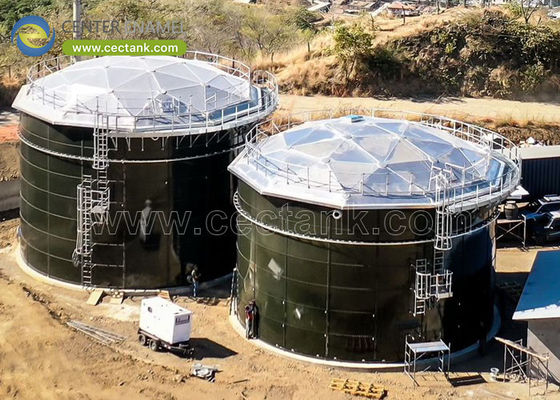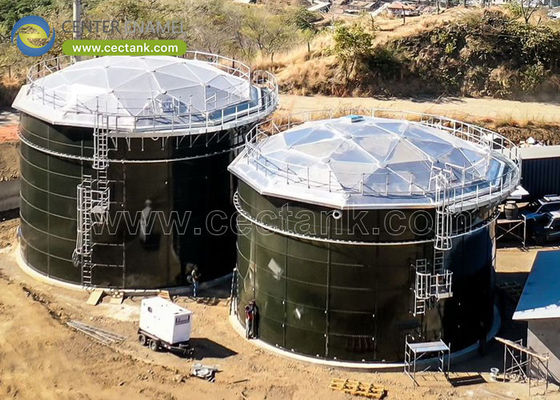-
Glass Fused To Steel Tanks (419)
-
Stainless Steel Tanks (421)
-
Fusion Bonded Epoxy Tanks (424)
-
Galvanized Steel Tanks (321)
-
Aluminum Dome Roofs (947)
-
Wastewater Storage Tanks (226)
-
Welded Steel Tanks (297)
-
Pressure Vessels (295)
-
Anaerobic Digester (201)
-
Industrial Water Tanks (349)
-
Glass Lined Steel Tanks (180)
-
Bolted Steel Tanks (181)
-
Sludge Storage Tank (115)
-
Biogas Storage Tank (173)
-
Leachate Storage Tanks (133)
-
Agricultural Water Storage Tanks (179)
-
Fire Water Tank (166)
-
Grain Storage Silos (130)
-
Biogas Projects (349)
-
Wastewater Treatment Projects (270)
-
Double Membrane Roof (223)
Elevating Wastewater Treatment Center Enamel's Superior Aluminum Dome Roofs for Aeration Tanks
| Place of Origin: | China |
| Brand Name: | Center Enamel |
| Certification: | ISO 9001 |
| Model Number: | Aluminum Dome Roofs |
| Minimum Order Quantity: | 1 |
| Price: | 100-50000 |
| Packaging Details: | 2000 |
| Delivery Time: | 8 weeks |
| Payment Terms: | L/C, T/T |
| Supply Ability: | 6000 |
|
Detail Information |
|||
Product Description
Elevating Wastewater Treatment – Center Enamel's Superior Aluminum Dome Roofs for Aeration Tanks
In the critical realm of wastewater treatment, operational efficiency, long-term durability, and cost-effectiveness are paramount. Aeration tanks, as the pulsating heart of biological treatment processes, demand robust and reliable infrastructure to ensure optimal performance and environmental compliance. Traditional roofing solutions for these vital tanks have often fallen short, succumbing to the harsh, corrosive environments characterized by high humidity, aggressive chemicals, and volatile organic compounds (VOCs). This leads to frequent maintenance, premature degradation, and significant operational disruptions.
Shijiazhuang Zhengzhong Technology Co., Ltd., globally recognized as Center Enamel, has emerged as a trailblazer in this sector, providing innovative and superior solutions that address these pervasive challenges. With decades of expertise in engineered storage solutions, Center Enamel’s specialized Aluminum Dome Roofs represent a paradigm shift for aeration tank enclosures. Meticulously designed and expertly fabricated, these cutting-edge roofing systems offer an unparalleled combination of corrosion resistance, structural integrity, ease of installation, and a significantly extended service life, making them the definitive choice for modern municipal and industrial wastewater treatment facilities worldwide.
As a leading storage tank manufacturer worldwide. Center Enamel can provide Glass Lined Steel(GLS) tanks, fusion bonded epoxy tanks, stainless steel tanks, galvanized steel tanks and aluminum geodesic dome roofs, Wastewater and Biogas Project Equipments for global customers.
| Configuration of Customized Storage Tanks | ||||
| Storage tanks | Volume | Roofs | Application | Design Requirements |
|
GLS Tanks SS Tanks Fusion Bonded Epoxy Tanks Galvanized Steel Tanks Welded Steel Tanks |
<1000m³ 1000-10000m³ 10000-20000m³ 20000-25000m³ >25000m³ |
ADR Roof GLS Roof Membrane Roof FRP Roof Trough Deck Roof |
Wastewater Treatment Project Drinking Water Project Municipal Sewage Project Biogas Project Fire Water Storage Project Oil Storage Project |
Water Supply & Drainage System Seismic Design Wind Resistant Design Lightning Protection Design Tank Insulation Design |
WasteWater Treatment Project Equipment Supply
| Pretreatment Equipment | Resource Utilization System | Sludge Treatment System | Other Equipment |
|
Mechanical Bar Screen Solid-liquid Separator Submersible Mixer |
Gas Holder Boiler System Boost Fan Bio gas Generator Torch System Dehydration and Desulfurization Tank |
PAM Integration Dosing Device Screw Sludge Dewatering Machine Slurry Separation Centrifuge |
Sewage Pump Mud Scraper Submersible Sewage Pump Three-phases Separator |
The Challenges of Aeration Tank Enclosures
Aeration tanks are dynamic environments. The continuous bubbling of air, often enriched with oxygen or other gases, creates a highly humid atmosphere. Furthermore, the biological processes within these tanks generate a cocktail of gases, including hydrogen sulfide (H2S), ammonia (NH3), and various organic vapors. These compounds are inherently corrosive, aggressively attacking conventional roofing materials such as concrete, steel, or even less robust aluminum alloys.
The consequences of material degradation are severe and multifaceted:
Structural Compromise: Corroded roofs lose their structural integrity, posing safety risks and potentially leading to catastrophic collapse.
Increased Maintenance Burden: Constant repairs, repainting, and replacement cycles drive up operational expenditure (OPEX) and divert resources.
Odor Emission: Deteriorated roofs often fail to provide adequate containment, allowing noxious odors to escape, leading to community complaints and regulatory issues.
Loss of Heat/Energy Inefficiency: Poorly insulated or compromised roofs can lead to significant heat loss, impacting biological process efficiency and increasing energy consumption, especially in colder climates.
Algae Growth and Contamination: Open or compromised tanks are susceptible to sunlight penetration, promoting algae growth, which can disrupt treatment processes and lead to higher chemical usage.
Reduced Asset Lifespan: The need for premature replacement of roofing systems significantly shortens the overall lifespan of the aeration tank asset.
These challenges underscore the urgent need for a durable, low-maintenance, and high-performance roofing solution that can withstand the unique rigors of the wastewater treatment environment.
Why Aluminum Dome Roofs? The Center Enamel Advantage
Center Enamel's Aluminum Dome Roofs stand apart as the optimal solution for covering aeration tanks, primarily due to the inherent properties of aluminum and Center Enamel's superior engineering and fabrication processes.
Unrivaled Corrosion Resistance: Aluminum, particularly the grades used by Center Enamel (e.g., 6061-T6, known for its excellent strength-to-weight ratio and corrosion resistance), naturally forms a passive oxide layer that provides exceptional protection against the corrosive gases and humidity prevalent in aeration tank environments. Unlike steel, which requires constant painting and maintenance to prevent rust, aluminum's self-protecting layer ensures long-term integrity without significant upkeep. This translates directly into a dramatically extended service life and reduced lifecycle costs.
Lightweight yet Structurally Robust: Aluminum's impressive strength-to-weight ratio is a significant advantage. This lightweight characteristic simplifies transportation, reduces installation time, and minimizes the load on the existing tank structure, potentially negating the need for costly structural reinforcements. Despite being lightweight, Center Enamel’s domes are engineered as robust, self-supporting structures. Their geodesic design distributes loads efficiently, providing exceptional stability and resistance to wind, snow, and seismic events, far surpassing the capabilities of flat or less engineered covers.
Speed and Ease of Installation: Center Enamel’s Aluminum Dome Roofs are designed for rapid, on-site assembly. The modular, pre-fabricated components are precision-engineered to fit seamlessly, significantly reducing construction time and labor costs. This "bolt-together" design means less disruption to ongoing operations, a critical factor for operational wastewater treatment plants. The self-supporting nature of the dome also often eliminates the need for internal support columns, maximizing internal tank space and simplifying future maintenance activities within the tank.
Superior Odor Control and Environmental Protection: The tight, sealed construction of Center Enamel's aluminum domes effectively contains noxious odors and VOCs, preventing their release into the atmosphere. This not only improves air quality for plant personnel and surrounding communities but also assists facilities in meeting increasingly stringent environmental regulations. Furthermore, the opaque nature of the dome prevents sunlight penetration, inhibiting algae growth within the tank, which can interfere with treatment processes and lead to increased chemical usage.
Minimal Maintenance and Long-Term Cost Savings: The inherent corrosion resistance of aluminum, combined with the robust design and precision manufacturing, results in a virtually maintenance-free roofing solution. There's no need for periodic repainting, rust removal, or extensive structural checks that are common with other materials. This drastically reduces operational expenditure over the lifespan of the tank, offering substantial lifecycle cost savings and a superior return on investment.
Engineering Excellence: The Center Enamel Difference
At Center Enamel, engineering precision is at the core of every Aluminum Dome Roof. Our design philosophy integrates advanced structural analysis with practical application needs. Each dome is custom-engineered to the specific diameter of the aeration tank, ensuring a perfect fit and optimal performance. We utilize state-of-the-art CAD/CAM software for design and fabrication, guaranteeing the highest levels of accuracy and component quality.
Our domes are constructed from high-strength aluminum alloys, typically 6061-T6 or similar, renowned for their structural integrity and resistance to environmental degradation. The geodesic framework is composed of triangular panels and struts, creating an incredibly strong, self-supporting structure that can withstand significant external loads. The components are manufactured under strict quality control, ensuring consistent excellence and easy assembly on site. The result is not just a cover, but a durable, long-lasting protective enclosure that enhances the efficiency and safety of the entire wastewater treatment process.
Benefits Beyond the Roof: Holistic Advantages for Wastewater Treatment Plants (approx. 100 words)
Beyond the direct benefits of corrosion resistance and structural integrity, Center Enamel's Aluminum Dome Roofs contribute to the overall optimization of wastewater treatment plants:
Process Stability: By protecting the aeration tank from external elements (rain, debris, UV radiation), the dome helps maintain stable internal conditions, crucial for consistent biological activity.
Improved Safety: A secure, enclosed tank reduces the risk of accidental falls into the tank and provides a safer working environment for plant personnel.
Energy Efficiency: While not primary insulators, the enclosed space can contribute to more stable temperatures within the tank, potentially leading to marginal energy savings by reducing heat loss in colder climates.
Aesthetics: The sleek, modern design of an aluminum dome can significantly improve the visual appeal of a wastewater treatment facility, contributing to a more positive public perception.
Detailed Technical Specifications: Go into more depth on the specific aluminum alloys used, panel thicknesses, bolt types, sealing mechanisms, and design standards (e.g., ASCE 7 for loads, specific international codes).
Construction and Installation Process: Elaborate on the steps involved in fabricating, shipping, and erecting the dome. Discuss the minimal equipment required and the reduced construction footprint.
Quality Control and Testing: Discuss Center Enamel's internal quality assurance procedures, material testing, and any third-party certifications.
Case Studies/Applications: This is where you can truly shine. Describe 2-3 specific projects where Center Enamel's domes were used for aeration tanks. Include:
The client and location.
The challenges they faced with previous solutions.
Why Center Enamel's dome was chosen.
The benefits realized after installation (e.g., odor reduction, maintenance savings, improved process).
Perhaps include quotes from satisfied clients (if available).
Environmental Impact and Sustainability: Beyond odor control, discuss the recyclability of aluminum, the long lifespan reducing waste, and any other "green" credentials.
Comparison with Other Roofing Materials: A more in-depth comparison table or section outlining the pros and cons of concrete, steel, fabric, and other less suitable options versus aluminum domes for aeration tanks.
Cost Analysis and ROI: While touched upon, you could dedicate a section to a more detailed explanation of the long-term cost savings, lifecycle cost analysis, and return on investment. Quantify potential savings where possible.
After-Sales Support and Service: Discuss warranties, technical support, and spare parts availability.
Global Reach and Experience: Emphasize Center Enamel's international project experience and ability to serve clients worldwide.




